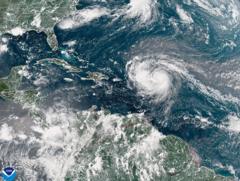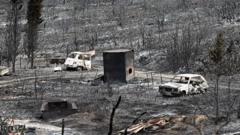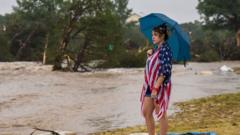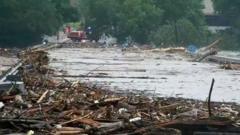Forecasters indicate it could result in significant rainfall and hazardous surf along several coastal regions.
Hurricane Erin Hits Category Five, Expected to Bring Life-Threatening Conditions
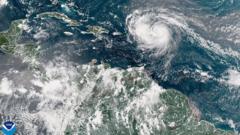
Hurricane Erin Hits Category Five, Expected to Bring Life-Threatening Conditions
The rapidly intensifying Hurricane Erin poses a severe threat to the Caribbean and the eastern U.S. coast.
As Hurricane Erin escalates to a category five storm with maximum sustained winds of 160 mph (260 km/h), meteorologists at the National Hurricane Center claim the hurricane has undergone "explosive intensification." The storm originated from a tropical depression and intensified quickly over the course of a day. The storm's trajectory suggests it will move northward, passing east of Puerto Rico, the Virgin Islands, and the Leeward Islands throughout the weekend. Forecasters warn of potential rainfall reaching 6 inches (15 cm), raising concerns about flash flooding and mudslides in the affected areas.
Currently, Erin is the first hurricane of the 2025 Atlantic season and is not predicted to make landfall in the mainland United States; however, it is expected to cause dangerous surf conditions along the east coast next week. As the storm progresses, areas like Florida and the mid-Atlantic states may experience severe surf hazards. The Bermuda region could also be at risk of heavy rainfall and hazardous surf due to Erin's presence.
In response to gale force winds linked to Hurricane Erin, the U.S. Coast Guard has enacted navigation restrictions for ports in St. Thomas and St. John in the U.S. Virgin Islands, as well as for various municipalities in Puerto Rico, including San Juan. The National Oceanic and Atmospheric Administration (NOAA) has characterized this Atlantic hurricane season as likely to be above average, attributing the potential increase in intense storms to ongoing global climate changes.
Currently, Erin is the first hurricane of the 2025 Atlantic season and is not predicted to make landfall in the mainland United States; however, it is expected to cause dangerous surf conditions along the east coast next week. As the storm progresses, areas like Florida and the mid-Atlantic states may experience severe surf hazards. The Bermuda region could also be at risk of heavy rainfall and hazardous surf due to Erin's presence.
In response to gale force winds linked to Hurricane Erin, the U.S. Coast Guard has enacted navigation restrictions for ports in St. Thomas and St. John in the U.S. Virgin Islands, as well as for various municipalities in Puerto Rico, including San Juan. The National Oceanic and Atmospheric Administration (NOAA) has characterized this Atlantic hurricane season as likely to be above average, attributing the potential increase in intense storms to ongoing global climate changes.

